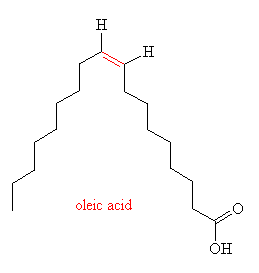
Oleic Acid (also called cis-9-octadecenoic acid) is an example of a fatty acid found in animal and vegetable oils. It is a mono-unsaturated fatty acid, due to the presence of a single double bond. The physical properties of fatty acids like oleic acid are determined by the number, geometry, and position of the double bonds in the chain, along with the degree of unsaturation (i.e. number of double bonds). In naturally occurring fatty acids, such as those found in vegetable oils, the double bonds are all in the cis configuration (shown in red in the figure), making the molecules bent or curved. This also makes the molecules much less flexible than those of fully saturated fatty acids (e.g. stearic acid). Their bent shape also hinders crystallisation, and explains why these acids are oils at room temperature. (Saturated acids have straight chains and can pack easily into a crystal lattice, and so are solid at room temperature, e.g. butter).

Unsaturated fatty acids are a good energy reserve, and are found in abundance in many meats. Pork, lamb and chicken fats all contain a higher proportion of unsaturated fats than beef and so feel softer to the touch. Plant seeds, too, are a good source of these fats, where they act as a compact efficient food reserve. They can be found in plants as diverse as corn, cottonseed, soybean, rapeseed, safflower and sunflowers. Oleic acid itself is the main fatty acid in the olive oil pressed from the ripe fruit of the olive (olea europaea). It was also featured in the recent Hollywood film 'Lorenzo's Oil'. In a rare genetic illness called adrenoleukodystophy (ALD), young boys suffer from an excess of harmful long chain (C24-C26) fatty acids which causes the myelin around nerves cells to deteriorate, leading to brain damage. They progressively lose more of their faculties, speech, movement, etc., until they eventually die. It was discovered that ingestion of large quantities of pure oleic acid triglyceride (mixed with around 25% of the related C22 acid, erucic acid) prevented the build up of the harmful longer chained acids, relieved all the symptoms associated with the disease, and allowed the sufferers to lead a normal life. This works by essentially keeping the enzyme responsible for biosynthesis of the acids busy metabolising these harmless acids, and so they have no resources left to produce the harmful ones.
 |  |
| Meat - a good source of unsaturated fatty acids | An olive tree in italy. Olive oil is one of the main sources of oleic acid. |
Oleic acid is also present in the cocoa butter of chocolate as one component of a triglyceride. The other two components are often either stearic acid, or the closely related palmitic acid. This means that the triglyceride has a much more uniform structure than is normally found in most fats and oils - and this uniformity results in a sharper than normal melting point. This allows chocolate to remain stiff almost up to its melting point (34°C). When it does melt, the melting occurs suddenly and endothermically. If this occurs in the mouth it gives a feeling of coolness - perhaps one of the reasons for the lasting popularity of chocolate (along with its sweetness due to the added sugar).